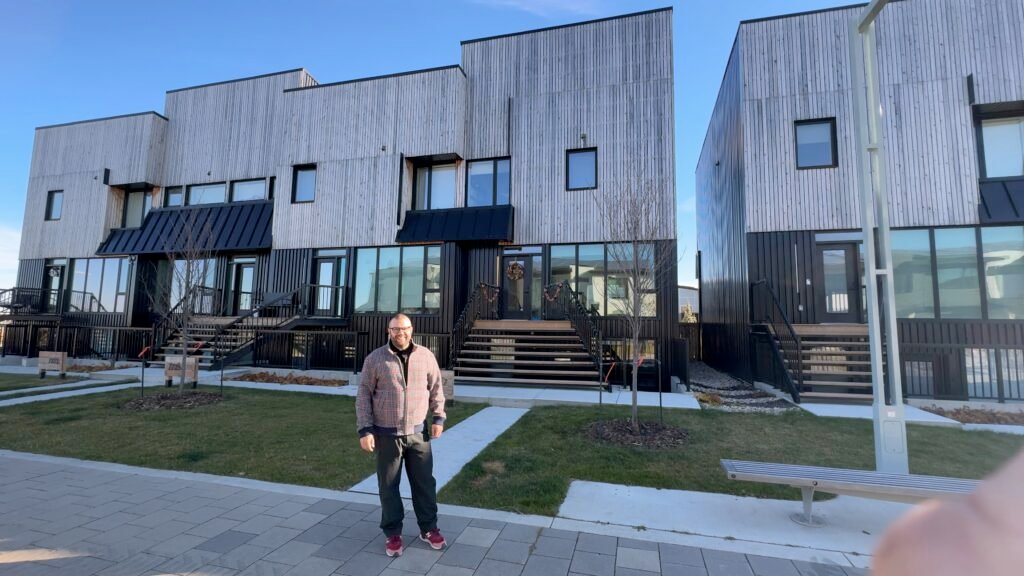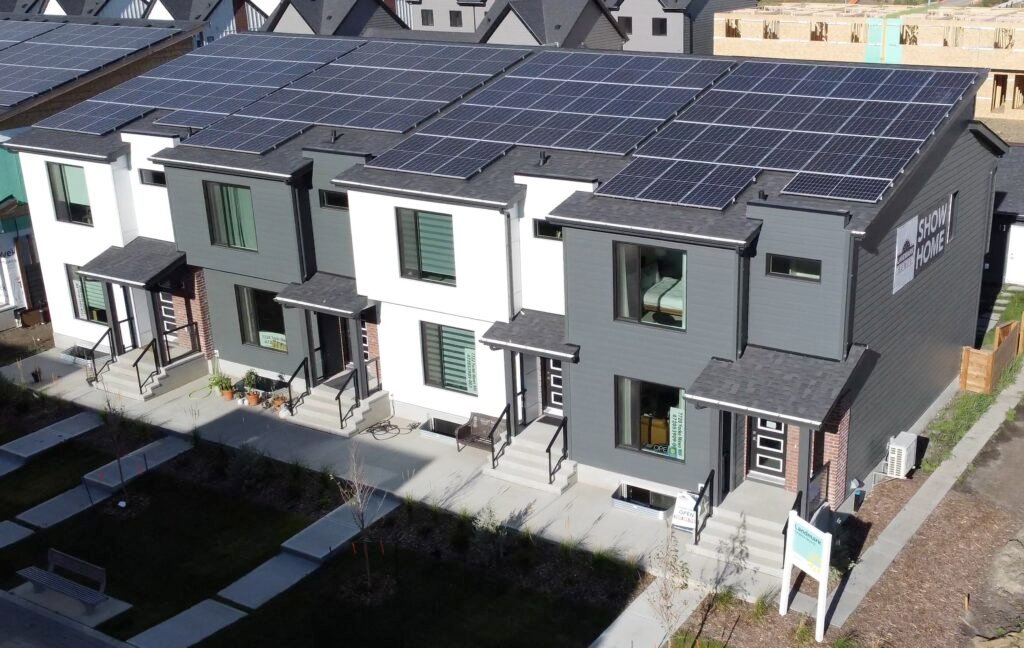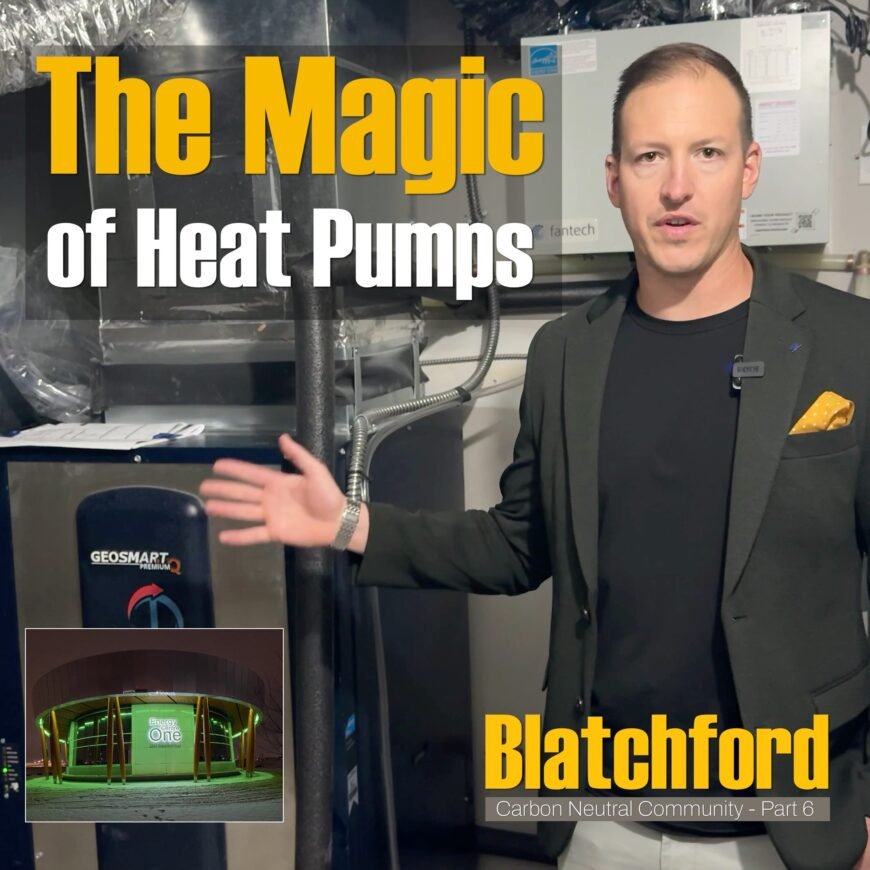Blatchford Carbon Neutral Community Series – Part 6
Table of Contents
By David Dodge, GreenEnergyFutures.ca
Electrification of heating systems is a revolution that is well underway, and not surprisingly, heat pumps are the most efficient way to heat and cool buildings.

The Blatchford Carbon Neutral Community uses an innovative geoexchange district heating system that draws heat from the Earth and uses it to effortlessly heat and cool the homes of this amazing sustainable community.
While geoexchange (often called geothermal) heating systems are not new— there are more than 100,000 systems in Canada already— district geoexchange systems are not that common in Canada.
Ironically, district heating is also an old idea that is being used around the world, but by combining it with geoexchange, you get an extremely reliable and energy-efficient system that can provide zero-emission heating and cooling.

Harvesting the heat of the Earth
As Christian Felske, director of the Blatchford Renewable Energy Utility, explains, the Blatchford system has 570 bore holes that go 150 meters beneath the lake at Blatchford. The pipes in these lines harvest the heat of the Earth, about 8-10 degrees C.

Then the fluid is fed into Energy Center One, a building near the lake that has a giant heat pump in it, which further upgrades the temperatures before sending the preheated fluids off to the homes of Blatchford.
Then smaller heat pumps in each home further upgrade the heat to provide a cozy, warm, consistently heated environment.

Heat pumps in the homes
We met up with Steve Oslanski of Envirotech Geothermal to learn what happens next.
The lines containing the preheated fluids from the Energy Center come into the home through the basement floor and are fed into a smaller heat pump in the home.
And in the home, heat pumps can provide just about any type of heating you want. Oslanski is standing beside a Geosmart quad-function heat pump in a garage with a suite above the garage.
“It does forced-air heating and cooling as well as floor heat,” he says. The forced-air unit heats the garage suite, and a separate part of the unit provides hydronic in-floor heating to the garage. This, he says, is to satisfy the need for separate heating systems for legal suites, whether they are garage suites or basement suites.
The home we are in has both a basement suite and a garage suite, offering two rental units in one home to a market desperate for new housing.
The amazing part about the heat pumps is that they are up to 400% efficient at heating homes and up to 700% efficient at cooling homes. The same unit provides heating and cooling. And at that level of efficiency, the unit uses very little energy to cool homes during those increasingly common summer heat waves.

Skeptical at first, residents love the heat pumps
Josh Culling was one of the early residents of the Blatchford community. “I was skeptical that it would do a very good job at first.”
But “The first day we moved into our house or took possession of it, it was a heat wave. And we walked into the house and it was like walking into a walk-in freezer, it was astounding,” he says.
Josh says he’s “never forgotten that moment.” Blatchford is located in the most northerly big city in North America, and astonishingly, heat waves in recent years have reached temperatures of up to 37 C, which for people living in this northern climate is very hot.

Heather MacKenzie and Justin Wheler are two other early residents of Blatchford experiencing heat pumps for the first time here.
“I do feel embarrassed about it, because everyone else is suffering and you’re just sitting at home blissful,” Heather says.
“We don’t notice the hot days or the cold days other than when we go outside,” says Wheler, who noted his dog sometimes wants to go outside in the summer to warm up in the sunshine after being inside the cool, air-conditioned home.
Heat pumps are also used in most of the homes in Blatchford to provide hot water to the homes. This electrifies the hot water system but makes the process much more energy efficient thanks to the heat pump technology.

Air-source heat pumps too
In Blatchford, Landmark Homes is using air-source heat pumps instead of ground-source heat pumps to heat their homes.

As Micah Dueck of Landmark explains, the company has been perfecting its formula for building super energy-efficient homes for 25 years. In 2018, Landmark built the most affordable net-zero home in Canada.
And this is where Landmark is different in Blatchford. They have replicated their net-zero homes in Blatchford using air-source heat pumps instead of ground-source heat pumps.
This means these heat pumps extract heat from the air instead of the pre-heated fluids from the geoexchange loops of the district energy system.
And yes, it seems like magic, but these heat pumps are rated to -30C and can extract heat from the air down to -30C and have no trouble cooling the home when the mercury climbs to +35C. The energy efficiency of the heat pump declines with temperature, but they still only rarely need the electric resistance backup heating built into the forced air heat pump systems.

Batteries included – Utility costs not included
What this means in the Landmark Homes is that they only have a utility hook-up, and that’s to the electricity grid. This means no gas bill, and thanks to the 9-10 kilowatts of solar included with every Landmark home, the home produces all of the energy the home needs on a net-annual basis. This also means it’s possible to make enough money from the solar to completely cover the electricity bill each year.
Yes, this means essentially no utility costs.
And Landmark’s homes in Blatchford are also part of a pilot program to include a 20-kilowatt-hour battery in every home.
As Landmark founder Reza Nasseri says, “The concept of net zero then comes from the fact that when you net everything out, it doesn’t cost you anything. But as we said before, if you have batteries, then that’s a double whammy. They start to actually make extra money.”
The batteries are part of a pilot program supported by Emissions Reduction Alberta to test batteries in homes and interconnect them as a virtual power plant to provide electricity to the grid during spikes in demand, thus producing more revenue.
The many Geos of Geoexchange
There are advantages to the geoexchange district heating system, too. It’s very robust and super reliable, and there are projects emerging all around the world providing renewable energy heating systems to entire neighbourhoods.
In some cases, these low-temperature district heating systems use waste heat, such as in Venne, Germany, where waste heat from a waffle cone plant heats 2,000 homes.
False Creek in Vancouver uses waste heat from the sewer system to heat the buildings there. And Toronto Western Hospital uses new technology to harvest heat from the wastewater system to heat an entire hospital complex. (watch for a future Green Energy Futures story).
And speaking of sewer heat, Blatchford is also planning a future phase of district heating using a sewer heat exchange system as well.
And there is a large geothermal project being built by EAVOR, an Alberta-based company in Geretsried, Germany. They’re drilling 4.5 km deep and then installing more than 300 km of pipe horizontally at depth to harvest higher temperatures from the Earth.
And yes, this is an actual “geothermal” project that uses a closed-loop system, which apparently can work anywhere in the world.
The project will harvest enough thermal energy to heat 120,000 homes in a district heating system and provide electricity to power 8,000 homes as well.
Heat pumps are the future of heating systems. And although geoexchange systems are the most reliable and consistent sources of heat, they are rarely economical for single-family homes. The sweet spot for geoexchange may be medium-sized buildings that build their own independent system, just like the Salvation Army did at Grace Village, a 175-unit supportive housing complex in Edmonton, Alberta. they expect to save $6 million on utility costs thanks to their geoexchange system coupled with solar.
But the fastest growing technology is the Air-Source Heat Pump. This affordable solution is now capable of heating homes in cold climates thanks to dramatic improvements in performance with units that are now rated to -35C.
I installed one in my cabin in the cold Canadian north against the advice of some experts and survived -41 in the first winter.
And with climate-induced weather extremes the fact that heat pumps provide super energy-efficient air conditioning is a big benefit.
Blatchford is deploying many kinds of heat pumps, and nearly everyone we spoke to loved the systems once they’d experienced them
Watch for future episodes and be sure to subscribe on YouTube or to our CKUA.com Radio podcast.
Green Energy Futures CKUA.com Podcast
Video Playlist: Blatchford 6-part Series
Audio Podcast Playlist: Blatchford 6-part series (CKUA Radio)

